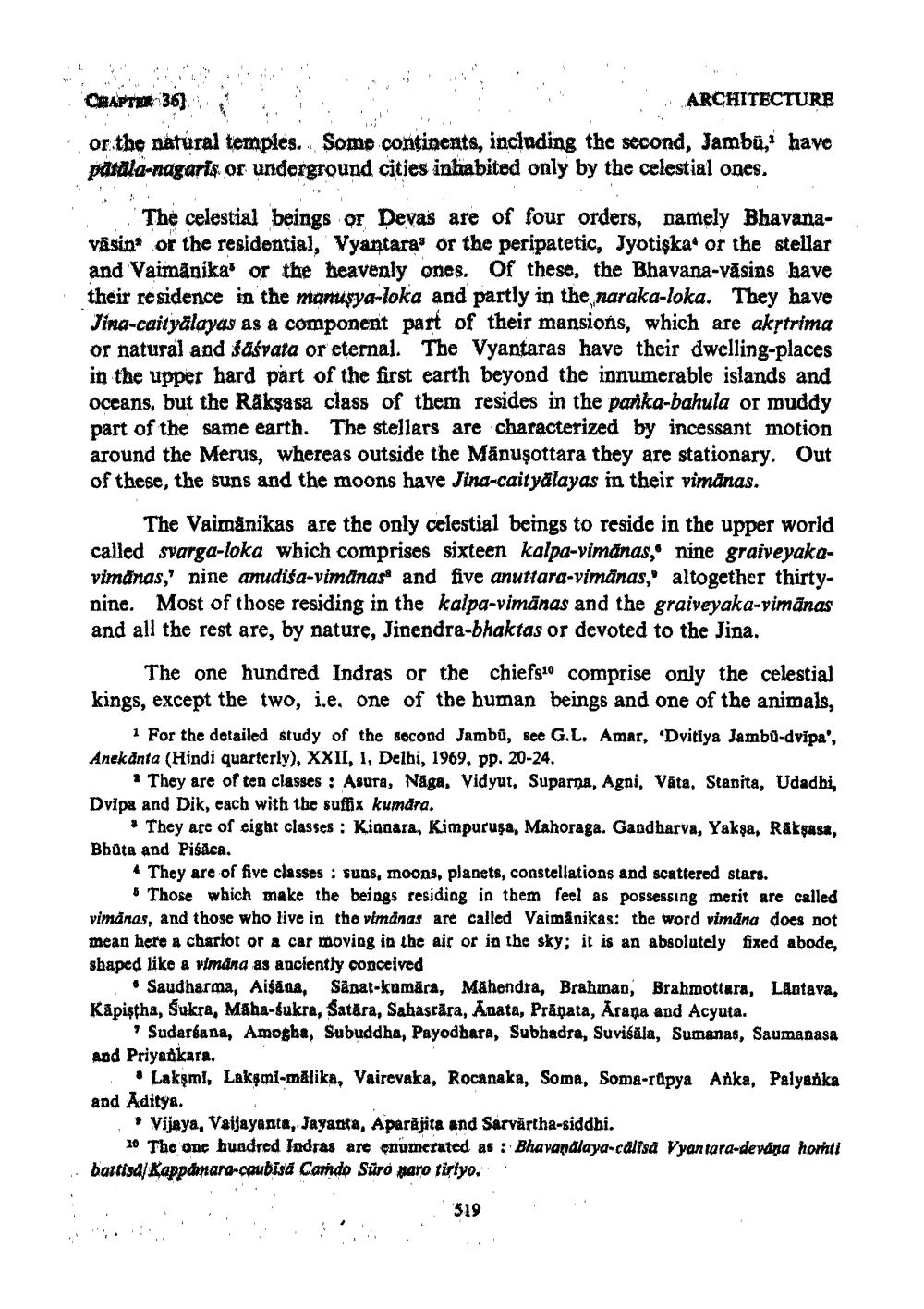________________
CHAPTER 36).
ARCHITECTURE or the natural temples. . Some continents, including the second, Jambut have pdidla-nagaris or underground cities inhabited only by the celestial ones.
The celestial beings or Devas are of four orders, namely Bhavanaväsin* or the residential, Vyantaraor the peripatetic, Jyotiska or the stellar and Vaimnānika or the heavenly ones. Of these, the Bhavana-väsins have their residence in the manusya-loka and partly in the naraka-loka. They have Jina-caityälayas as a component part of their mansions, which are akstrima or natural and fasvata or eternal. The Vyantaras have their dwelling-places in the upper hard part of the first earth beyond the innumerable islands and oceans, but the Raksasa class of them resides in the parka-bahula or muddy part of the same earth. The stellars are characterized by incessant motion around the Merus, whereas outside the Mānuşottara they are stationary. Out of these, the suns and the moons have Jina-caityalayas in their vimanas.
The Vaimānikas are the only celestial beings to reside in the upper world called svarga-loka which comprises sixteen kalpa-vimänas, nine graiveyakavimänas,' nine anudiśa-vimānasa and five anuttara-vimänas," altogether thirtynine. Most of those residing in the kalpa-vimānas and the graiveyaka-vimānas and all the rest are, by nature, Jinendra-bhaktas or devoted to the Jina.
The one hundred Indras or the chiefs10 comprise only the celestial kings, except the two, i.e, one of the human beings and one of the animals,
1 For the detailed study of the socond Jambû, see G.L. Amar, Dvitiya Jambu-dvipa', Anekanta (Hindi quarterly), XXII, 1, Delhi, 1969, pp. 20-24.
They are of ten classes : Asura, Någa, Vidyut, Suparna, Agni, Väta, Stanita, Udadhi, Dvipa and Dik, each with the suffix kumara.
• They are of eight classes : Kinnara, Kimpuruşa, Mahoraga. Gandharva, Yakşa, Raksasa, Bbūta and Pisaca.
* They are of five classes : suns, moons, planets, constellations and scattered stars.
Those which make the beings residing in them feel as possessing merit are called vimänas, and those who live in the vimanas are called Vaimäaikas: the word vimana does not mean here a chariot or a car moving in the air or in the sky; it is an absolutely fixed abode, shaped like a vimana as anciently conceived
• Saudharma, Aisina, Sanat-kumăra, Mahendra, Brahman, Brahmottara, Läntava, Kāpistha, Sukra, Maha-śukra, Satara, Sahasrāra, Anata, Prapata, Arana and Acyuta.
Sudarsana, Amogha, Subuddha, Payodhara, Subhadra, Suvisala, Sumanas, Saumanasa and Priyankara.
Lakşml, Lakşmi-malika, Vairevaka, Rocanaka, Soma, Soma-rupya Anka, Palyanka and Aditya.
Vijaya, Vaijayanta, Jayanta, Aparajita and Sarvärtha-siddhi.
10 The one hundred Indras are enumerated as : Bhavanälaya-cālisa Vyantara-devána hornti bartisdi Kappdmara-coubisa Cardo Süro Haro tiriyo.
319 :




